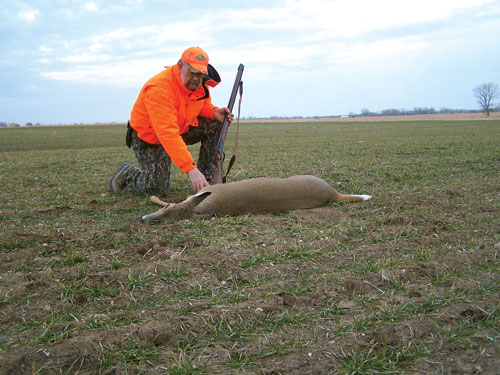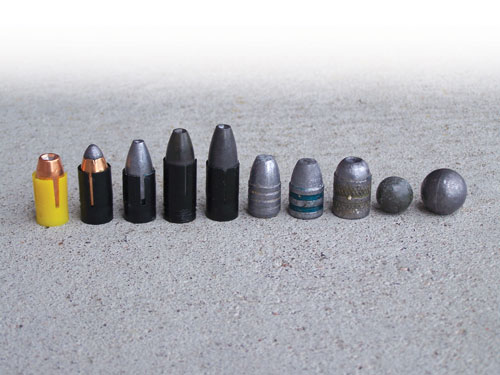 I hunted exclusively with muzzleloaders on our farm and throughout North America for well over 20 years and still hunt every Kansas muzzleloader season. I often harvest as many as three freezer does as well as a buck from our farm in a season. Experience has taught me that many modern in-line muzzleloaders set up with high-velocity loads are prepared for the exceptional whitetail hunting situation rather than the normal.
I hunted exclusively with muzzleloaders on our farm and throughout North America for well over 20 years and still hunt every Kansas muzzleloader season. I often harvest as many as three freezer does as well as a buck from our farm in a season. Experience has taught me that many modern in-line muzzleloaders set up with high-velocity loads are prepared for the exceptional whitetail hunting situation rather than the normal.
How many of you have taken a whitetail deer at 200 yards with any firearm? Not because you couldn’t but rather because it simply wasn’t necessary? The vast majority of whitetails are taken inside of 100 yards, even on the plains and prairies where I hunt. White-tailed deer remain relatively close to cover during legal shooting hours, either coming out or going in. Practical shooting distances naturally become from 50 to 100 yards. I seldom get a shot at a whitetail beyond 120 yards and hardly ever at 200.
Without discounting the trajectory advantages of a lighter sabot load, I believe that there are issues with high-velocity in-line muzzleloader loads involving accuracy, recoil, contamination and bullet performance. I received a number of e-mails from readers the two seasons following the .45-caliber in-line introductions of a few years back.
Remember how light sabot projectiles and magnum charge velocity claims were pushed back then? These hunters were hitting deer and not bringing them down. When they described the circumstances and reactions to their shots, I knew that it had to be either poor shot placement or penetration/bullet failure. I am inclined to believe that most of the time it was the latter. I still get those e-mails and letters from magnum-charged .45- and .50-caliber in-line shooters, and if they are not using one of the premium quality projectiles, bullet failure can be an issue. My first suggestion to them is to back off on the powder charge and choose a much heavier and/or a much better quality bullet. Nearly all of them gave me positive feedback later that season or the following year.
 Recoil can be significant when using a 150-grain powder charge in a 7-pound entry-level in-line. Heavy recoil can cause flinching and poor shot placement. A hunter should concentrate on tight groups and forget about velocity. A modest powder charge of no more than 120 grains and a projectile of no less than 300 grains can produce superior accuracy and still deliver heavy trauma to whitetail at practical hunting ranges.
Recoil can be significant when using a 150-grain powder charge in a 7-pound entry-level in-line. Heavy recoil can cause flinching and poor shot placement. A hunter should concentrate on tight groups and forget about velocity. A modest powder charge of no more than 120 grains and a projectile of no less than 300 grains can produce superior accuracy and still deliver heavy trauma to whitetail at practical hunting ranges.
A muzzleloader deer hunter is not going to experience poor performance from a light sabot load as long as shot placement is precise and the projectile is of superior quality. Then a muzzleloader hunter can put a deer down cleanly. But problems can still arise.
My Kansas muzzleloader deer season is in mid-September. It is often hot, foliage can be extremely heavy, and except for very narrow time periods at dawn and dusk, deer movement is limited. I often still hunt throughout most of the day, trying to catch whitetails napping. Movement must be along the edge of heavy cover where the deer are bedded to avoid unnecessary noise. Any shot opportunity is often fleeting and at very close range. A wounded deer can be difficult to locate in thick foliage and is easily lost. I want to accomplish two goals with my muzzleloader. I want bone-breaking power delivered to the shoulder area to incapacitate the deer as much as possible and I want a big hole producing heavy blood sign for location of the animal. Nothing beats a big bore, heavy lead conical under these circumstances.
Loads that have proven to be very effective for me are the 375-grain and 435-grain .50-caliber Buffalo SSB sabots with powder or pellet charges of 90 to 120 grains. The projectile is a swaged lead boattail hollow point. The Buffalo SSB loads easily, exhibits good accuracy and expands beautifully. The .54-caliber Hornady Great Plains bullet is a 435-grain conical that will exhibit identical performance. It will not rival the SSB loads at longer ranges, but is just fine for shots out to 150 yards. I have an older .54-caliber White Bison in-line carbine that is generally loaded with the 435-grain conical and a modest charge of 85 grains of blackpowder or Pyrodex RS. I will put it up against any muzzleloader for cleanly harvesting a whitetail out to 150 yards.
One of my favorite heavy-cover whitetail-hunting muzzleloaders is a Gary White custom .58-caliber Leman plains rifle replica. It is a big, heavy sidelock with primitive open sights. My normal load is a 260-grain round ball with a 120-grain blackpowder charge. It is fast on target for short-range shots, and its heavy barrel weight produces a stable sighting plain at longer ranges. Recoil traits are quite pleasant. At 100 yards where the vast majority of whitetail are encountered, the big .58-caliber round ball will consistently perform in spite of so-called unimpressive energy figures.
Choose a conical that loads easily in your particular rifle, choose a conical in a weight that is appropriate to the game you’re hunting, develop the most consistent and accurate load, and practice at appropriate ranges. If you follow this advice, you will have a superior whitetail muzzleloader that is pleasant to shoot, highly accurate and supremely effective.






